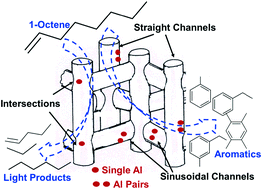Insight into the impact of Al distribution on the catalytic performance of 1-octene aromatization over ZSM-5 zeolite†
Abstract
To correlate the relationship between the Al distribution and the catalytic performance of long-chain olefin aromatization, several ZSM-5 zeolites with different Al locations and proximities were prepared via adjusting the hydrothermal synthesis conditions. Characterization by XRD, SEM and N2-adsorption indicated that all the as-prepared ZSM-5 zeolites exhibited high crystallinities, uniform morphologies and open channels. However, a great difference in the framework Al (AlF) positions was observed by 27Al MAS NMR and UV-vis-DRS of Co(II) ions, thus leading to the distinct acidity of various zeolites as determined by NH3-TPD and Py-IR. In 1-octene aromatization reaction, ZSM-5 catalysts exhibited significantly different catalytic performances and reaction pathways, which were closely related to the types and locations of the AlF atoms. The ZSM-5 zeolite catalyst with the most abundant single Al sites exhibited the lowest aromatics selectivity, while Al pairs in the framework were more favorable to the formation of aromatics. Moreover, the product distribution revealed that the Al pairs in the channel intersections of the ZSM-5 zeolite were responsible for the improved selectivity to heavy aromatics due to the fewer space restrictions; however, the Al pairs in the sinusoidal and straight channels with severe size restrictions suppressed the generation of bigger aromatics on the Al sites. This result provided a new potential method for precisely tailoring the catalytic selectivity in olefin conversion and upgrading the Fischer–Tropsch oil.



 Please wait while we load your content...
Please wait while we load your content...